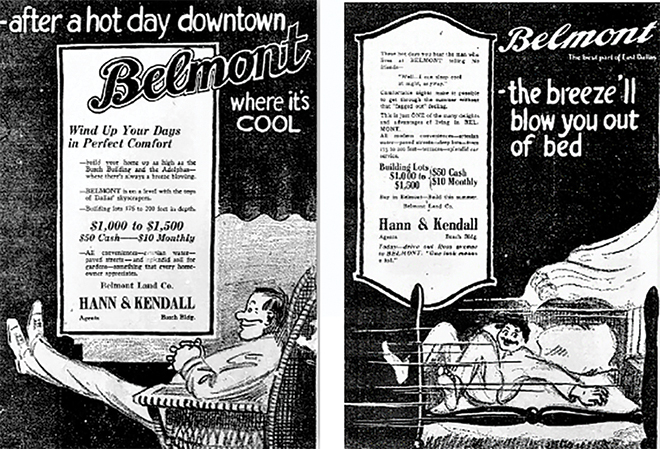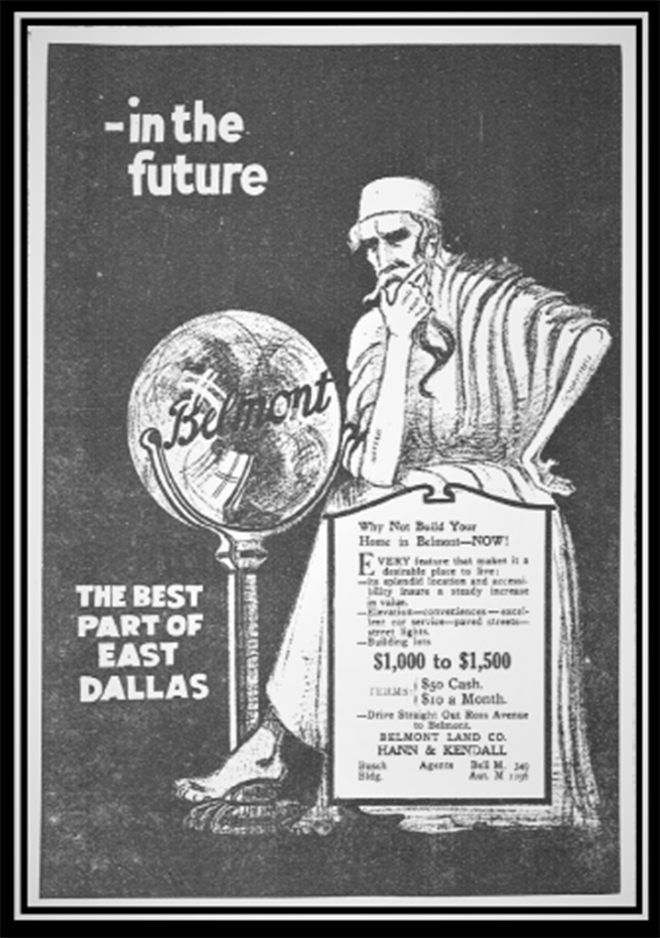Belmont residents Barry and Geyden Sage set out to unearth the long-lost history of their neighborhood, and in the process, they found a lost piece of Dallas history. They uncovered a plethora of articles, maps and advertising art promoting Belmont when it became a suburban addition to the city.
Henry Exall purchased the land that became Belmont on March 22, 1890. The land was later developed into what would become one of Dallas’ premier neighborhoods known for its large lots, paved streets, concrete sidewalks and variety of architectural styles.
More than 30 years later, The Belmont Land Company advertised the neighborhood with quirky maps and illustrations.
“The ads are creative, beautiful, funny and informative,” Geyden says. “We are sharing the images because we believe it may inspire people to look back and appreciate our rich history and the people who have paved the way for Dallas to be the great city that it is today.”
Photography compiled by Barry and Geyden Sage

Pictured Above: On May 1, 1890, Exall submitted the plat map introduing Belmont as a new addition to the City of Dallas. Exall moved to Texas from Virginia in 1887. That year, he married May Dickson, who is known for her famous dunning letter to Andrew Carnegie for his investment in the Dallas Public Library. She also renamed Exall Lane to Lovers Lane after noticing the couples parked along the dark road that ended at their Lomo Alto farm, where Exall raised standardbred racehorses. Exall also owned and planned to develop the land that is now Highland Park, which he intended to call Philadelphia Place.

Pictured Above: Belmont was the cool place to be. A perk of living in the neighborhood was relief from the intense summer heat. Advertisements claimed land in Belmont was level with the tops of Dallas skyscrapers. In a time when most homes didn’t have air conditioning, homeowners could build as high as the roof- top garden at the Adolphus Hotel, where a breeze was always blowing. You would not need a fan in Belmont, but you would want to sleep in your pajamas. At any given time, a breeze could just blow you out of bed.

Pictured Above: By 1912, the ads for Belmont got really creative. The neighborhood was established on what was known as “College Hill,” above the murky cloud of smoke and coal soot from the mills and factories downtown. Dallas’ finest neighborhoods were deteriorating under a blanket of filth. But not Belmont. The pure air quality had “the perfume of wildflowers” and would bring back roses to faded cheeks. Unlike the street urchins downtown, the kiddies in Bel- mont were “real children” playing with the “innocent zest of youth.”

Pictured Above: The Belmont Land Company and Realtors Hand & Kendall may not have had a crystal ball, but they knew the neighborhood’s location and amenities would ensure a steady increase in property values. At the time of this ad, lots in Belmont cost $1,000 to $1,500. Little did they know that more than 100 years later, the average cost of a lot in Belmont would top $300,000.





